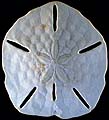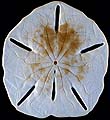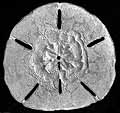The Echinoid Directory
Leodia Gray, 1851, p. 36
| Diagnostic Features |
|
|---|---|
| Distribution | Pliocene to Recent, East coast of America. |
| Name gender | feminine |
| Type | Leodia richardsoni Gray, 1851 (= Echinodiscus sexiesperforatus Leske, 1778, p. 199), by original designation. |
| Species Included |
|
| Classification and/or Status |
|
| Remarks |
|




